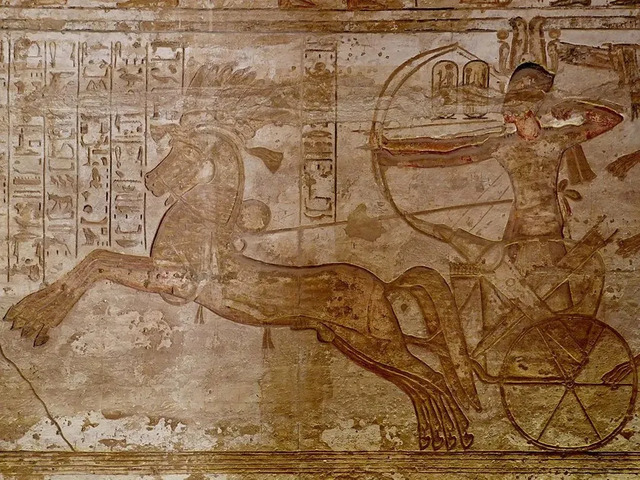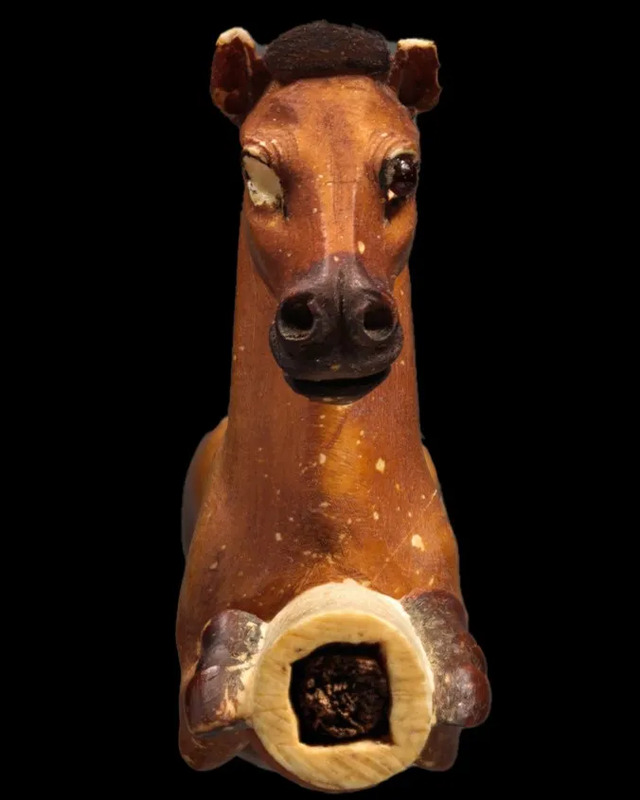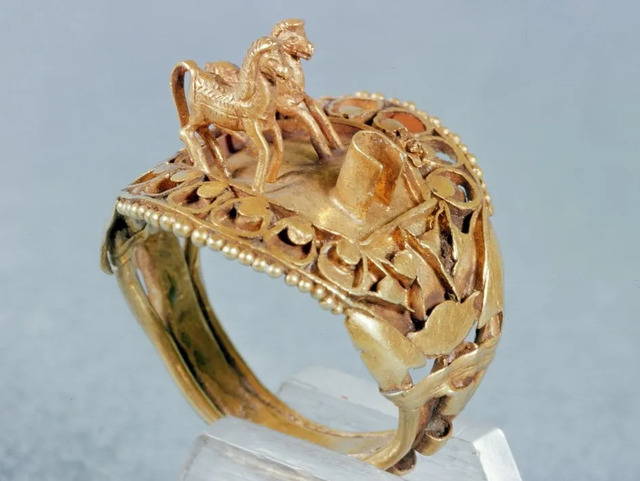In the heart of Ancient Egypt, the horse quickly became a symbol of power and prestige, its presence shaping military strategies and royal life. One exquisite artifact that highlights this transformation is an intricately carved ivory horse handle from the reign of Amenhotep III. With its lifelike details and symbolic significance, this piece not only reflects the artistry of Egyptian craftsmen but also offers a glimpse into a society where horses played an essential role in warfare, culture, and religion.
The Horse Handle: A Masterpiece of Ivory Carving
The horse handle, measuring 14.7 cm in length, 5.5 cm in height, and 2 cm in width, is an intricately carved object that likely served as a handle for a whip or perhaps a fly whisk. Made from ivory and stained with reddish-brown pigment, the handle’s form is that of a galloping horse, capturing the dynamism and elegance of the animal in motion. The horse’s mane is painted black, enhancing its realistic appearance, while garnet inlays in the eyes give it a lifelike glisten as light reflects upon them. Though one of the garnet eyes is missing, the remaining one still exudes a striking sense of realism, underscoring the skill of the ancient artisans.

The horse handle is not just a functional object but a work of art, showcasing the sophisticated carving techniques and intricate inlays that were characteristic of Egyptian craftsmanship. The use of garnet for the eyes is particularly significant, as ancient Egyptians had a longstanding fascination with inlaid eyes. This practice dates back to the Old Kingdom, where figures made of ivory often featured eyes crafted from precious stones. The use of such materials added a layer of mystique and prestige to the object, elevating it beyond a mere utilitarian item.
Video
Tune into this video from Odyssey to discover who created Ancient Egypt’s most iconic masterpieces and the scribes behind these timeless works.
The Historical Context: The Late 18th Dynasty

The horse handle was created during the reign of Amenhotep III, one of Egypt’s most prosperous pharaohs, who ruled from 1390 to 1352 BCE. This period, part of the 18th Dynasty, is known for its political stability, cultural flourishing, and diplomatic ties with neighboring regions. Amenhotep III’s reign saw the peak of Egypt’s influence, and the arts flourished under his patronage. The horse handle reflects the high level of craftsmanship achieved during this time, serving as a testament to the artistic and cultural achievements of the era.
While the specific location of the horse handle’s discovery remains unknown, it was part of the Carnavon Collection and acquired by the Metropolitan Museum of Art in 1926. Its inclusion in this prestigious collection further highlights its significance as an example of Egypt’s artistic legacy. The late 18th Dynasty is often considered a golden age in Egyptian history, and the horse handle epitomizes the opulence and refinement of the period.
The Role of Horses in Ancient Egypt

Horses, although not native to Ancient Egypt, became an integral part of Egyptian society after their introduction during the Second Intermediate Period (c. 1667–1570 BCE). This was a time of foreign domination by the Hyksos, who brought with them important innovations, including the horse and chariot. Initially, horses were used for warfare, but over time, they became symbols of power, wealth, and prestige.
By the New Kingdom (c. 1550–1070 BCE), horses had become central to Egyptian military strategies, particularly in the use of chariots. Pharaohs such as Amenhotep II and Ramses II used chariots extensively in military campaigns, which greatly enhanced the army’s mobility and combat effectiveness. Horses also symbolized royal power, often depicted in battle scenes, ceremonial processions, and artwork.
Horses in Egyptian Warfare and Society
The introduction of horses had a profound impact on Egyptian warfare. Chariotry became an essential component of Egypt’s military strength, and horses were used in battles and campaigns across the ancient world. The chariot was not only a weapon of war but also a symbol of the pharaoh’s divine right to rule. Pharaohs like Amenhotep III, Amenhotep II, and Ramses II were frequently depicted riding horses and chariots in artwork, emphasizing their military prowess and royal status.
Beyond their military use, horses were also associated with Egypt’s elite class. Owning and maintaining horses required significant resources, and they were often depicted in scenes that celebrated the wealth and status of the nobility. Horses were also used in ceremonial contexts, further cementing their symbolic role in Egyptian society.
Artistic Representations of Horses in Egyptian Culture

The depiction of horses in Egyptian art is notable for its attention to detail and realism. During the Amarna period, artists began to portray horses in more dynamic poses, such as galloping or rearing. The horse handle itself is a prime example of this artistic style, capturing the movement and grace of the animal with remarkable precision.
Horses were often shown alongside pharaohs and elites in artistic representations, reinforcing their status as symbols of power and prestige. These depictions were not limited to tombs and temples; they also appeared on everyday objects, such as the horse handle, which reflects the cultural significance of the horse beyond the royal court.
The Horse in Religious and Symbolic Life
In addition to their military and social importance, horses were also woven into the religious fabric of Egyptian society. They were associated with the sun god Ra, whose chariot was believed to race across the sky each day. The horse’s speed and power made it an ideal symbol for the solar chariot, embodying the sun’s journey through the heavens.
Horses were also associated with the divine, representing the strength and vitality of the gods. Their presence in religious rituals and iconography further highlights their symbolic significance in Egyptian culture. Despite their symbolic importance, horses were not used for agricultural or transport purposes, as donkeys and oxen remained the primary animals for labor.
The Horse Handle and Other Decorative Artifacts
In addition to the horse handle, many other artifacts from the New Kingdom period feature horses in their design. These include rings, jewelry, and decorative reliefs, all of which showcase the high level of artistry and craftsmanship achieved by Egyptian artisans. The horse handle, with its intricate carving and garnet inlays, stands as a testament to the skill and creativity of these craftsmen.

Other objects, such as the gold horse ring belonging to Ramses II, further illustrate the importance of horses in Egyptian society. These artifacts provide a glimpse into the material culture of the time and offer valuable insights into the role of horses in both everyday life and royal symbolism.
Video
Watch this full documentary to dive into the art of Egyptian hieroglyphs and explore the world of scribes in Ancient Egypt.
Conclusion: The Legacy of Horses in Ancient Egyptian Society
The horse handle is more than just a beautiful artifact; it is a symbol of the profound impact horses had on Ancient Egyptian society. From their introduction as foreign imports to their status as symbols of power, wealth, and divinity, horses played a central role in the military, art, and culture of Ancient Egypt. The horse handle, with its lifelike carving and garnet eyes, captures the essence of this importance and serves as a reminder of the artistic and cultural achievements of the New Kingdom.
The legacy of horses in Ancient Egypt continues to fascinate scholars and enthusiasts alike, offering a window into the past and shedding light on the sophisticated and dynamic society that once flourished along the banks of the Nile. Through artifacts like the horse handle, we gain a deeper understanding of Egypt’s military strategies, religious beliefs, and artistic traditions, all of which remain a testament to the enduring power and prestige of the pharaohs.



